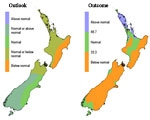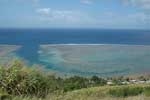PDF of this article (96 KB)


New Zealander heads world commission for agricultural meteorology
NIWA climate scientist Jim Salinger has been elected President of the Commission for Agricultural Meteorology of the World Meteorological Organization (WMO). The WMO is the United Nations agency with responsibility for issues relating to weather, climate, and the water cycle. The Commission for Agricultural Meteorology is one of the eight technical commissions of the WMO. It assists the 187 WMO member states and territories in the provision of climate, weather, and related services to the agricultural community. It has a wide-ranging work programme, including strengthening monitoring and early warning systems for weather-related disasters, increasing efficiency in water use, and improving agricultural production and quality. As President, Jim will oversee the Commission’s entire work programme and chair its management group. The Commission’s work on developing early warning systems for natural hazards – floods, windstorms, droughts, landslides, and heat waves – is particularly important. Over the past 10 years there has been a rising trend of natural hazards, with floods and droughts having the most severe effects on agriculture, forestry, and rangelands, and poor nations suffering the most. As an example, the Commission is working to improve monitoring systems for early detection of drought. This requires more accurate climate forecasts which make it possible to develop new early–warning systems.
For further information, contact: Dr Jim Salinger, 0-9-375 2053, [email protected]
Challenging work with a Fijian village

Fitting in with village life is just one of the challenges we face in a NIWA-led project to protect the health of Coral Coast villagers and the coral reef ecosystems on which they depend. Although a threatened coup never materialised, a series of three funerals and a wedding in the area demanded a very flexible programme for our early November workshop. We were there as part of a three–year NZAid project to develop and demonstrate sustainable waste-treatment systems for coastal villages.
NIWA is collaborating on the project with ESR, ecoEng, and the Institute of Applied Sciences at the University of the South Pacific. It is funded via MoRST through the NZ Official Development Assistance Government Agencies Contestable Fund.
We are working with the villagers of Votua to assess health risks and environmental effects, and develop sustainable wastewater treatment systems that are appropriate to their needs. This is a demanding task given the high nutrient sensitivity of the surrounding coral reef ecosystems. To improve health and environmental outcomes for the village, drinking water supplies and management of wastes from piggeries and nearby tourist resorts are key issues that must also be addressed.
With the support and commitment of the locals, we successfully merged our workshop into the busy village life. Together we identified water supply and wastewater management options for the village, collected design information, and implemented a monitoring programme of the existing infrastructure. The next step will be to use the information collected to design new water supply and wastewater systems for Votua.
For further information, contact: Dr Chris Tanner, 0-7-856 1792, [email protected]
Historic weather events
There are a number of lingering questions about the frequency and severity of weather–related hazard events. Are floods getting worse? How did this year’s South Island snow event compare with disruption and damage of past major snow storms? If the Great Cyclone of February 1936 occurred today, what would be the damage bill? All such questions are difficult to answer without the back–up of a consistent and well researched database of the severity and impact – on lives and livelihoods – of historic events up to the present. NIWA is one year into the collation and development of such a database as part of a research programme on quantifying risk from natural hazards. The primary focus is on damage and number of casualties, rather than just the size and nature of the event itself. So far we’ve received numerous ‘donations’ of various databases, and have perused many books and newspaper articles. But it is increasingly becoming clear that there is no single repository of such information. Our goal is to provide the historic storms database as a searchable facility for people and researchers to use. If you wish to contribute material or have any queries about the project, please get in touch.
For further information, contact: Dr Rob Bell, 0-7-856 1742, [email protected]
